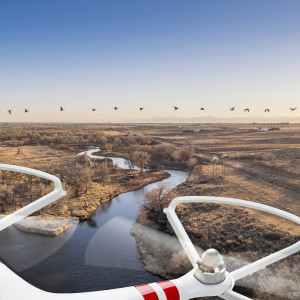A decade from now, your order from Amazon will likely be delivered to your doorstep by a drone. Want to order a pizza? Drones will probably deliver those, too.
And drones are already at work inspecting construction sites and cell phone towers and documenting damage for insurance claims. But the proliferation of drones will only happen if a system is developed to prevent them from colliding with each other.
NASA, along with the FAA, is working on that issue by developing technology that enables drones to broadcast their positions to nearby drones so they can avoid collisions. The collision avoidance system would be decentralized, much as it is today with automobile traffic. Drivers see and avoid each other, aided by traffic signals and rules of the road, without any central direction. Drive where you want, when you want, and follow the rules to avoid collisions.
But NASA’s system promises to be more reliable than driving because it relies on electronic technology rather than human drivers who might be tired, or texting, or drunk.
One advantage of a decentralized system, where drones avoid collisions with each other rather than being directed by a centralized air traffic control as airliners are, is that the capacity of the system can be much greater. This will be important as drones proliferate in the future.
If the system were designed like the current air traffic control system for airliners, which is a centralized system in which air traffic controllers direct pilots who then follow the controllers’ directions, capacity will be much more limited, and your drone-delivered pizza may not become a reality. Designed in the 1940s and barely changed since then, airliners report their positions to a controller, who then gives directions to aircraft so they remain separated.
Imagine a highway system that operated like the air traffic control for airliners. Drivers would have to file a travel plan and get it approved ahead of time, and a government controller would assign road space to ensure that cars remained separated. You have to stick to your driving plan, unless the controller alters it to avoid conflict with another vehicle. Such centralized highway control would severely limit the capacity of roadways, just as centralized air traffic control limits the capacity of airways.
The principle behind NASA’s proposed technology that enables drones to report their locations to other drones to avoid collisions by themselves is much like self-driving cars, but the big difference is that self-driving cars (currently) use their own sensors to look out for conflicts, with no information coming back from potential conflicting traffic. Drones would broadcast their positions to other drones, simplifying their ability to identify and avoid conflicts.
As with automobiles, and unlike with airline traffic, NASA’s proposed system would allow drones to fly where their owners wanted, when they wanted, without requiring permission from a government controller. But this same system could also be used for airline traffic, converting the current antiquated system of top-down air traffic control into a decentralized system in which aircraft electronically see and avoid each other. The technology for aircraft to see each other electronically already exists, and is already required for airliners.
One ironic aspect of NASA’s plan for drones is that, if implemented as it is planned, not only could it facilitate the proliferation of drones but it could also provide a model for modernizing our air traffic control system for airliners beyond its 1940s design and into the 21st century.

